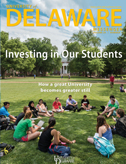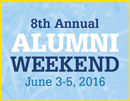Nursing celebrates 50 years
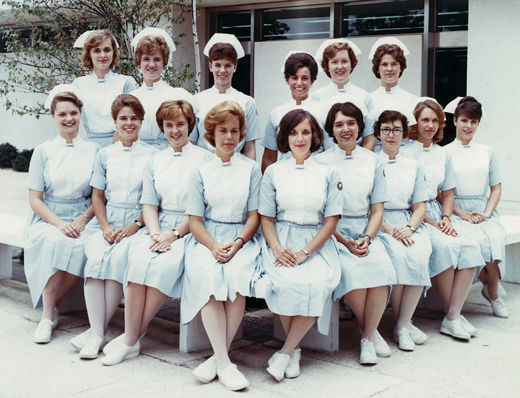
OUR UD | As the School of Nursing celebrates its 50-year anniversary in 2016, its students continue to build on a tradition of excellence in the classroom, at the bedside and far beyond.
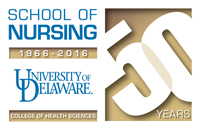
Today’s nursing students have more educational opportunities than ever before. And they follow a long line of well-trained UD nursing alumni whose work has helped redefine what it means to be a nurse.
“Health care looks much different today than it did 50 years ago, but our students continue to thrive in a rich educational environment that offers opportunities in the classroom, the community and around the world,” says Kathleen S. Matt, dean of the College of Health Sciences.
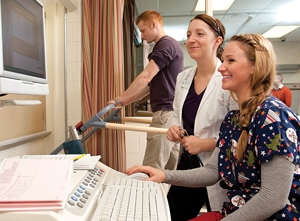
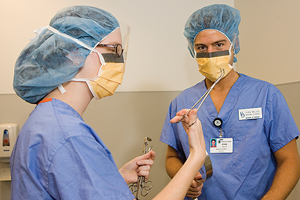
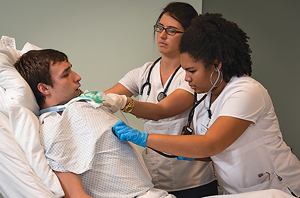
Take, for instance, Brianna Hafetz, HS16. As a sophomore, she was one of the first students to participate in the Nursing Alternative Spring Break in Kingston, Jamaica. There, she volunteered in an orphanage and made her first diagnosis, a self-described “monumental moment in a nursing student’s life.”
While opportunities have grown over the decades, some things have remained hallmarks of UD’s program; specifically, a commitment to excellence in education, as well as strong support for the program from health care organizations, alumni, faculty and donors.
As the recipient of the Muriel E. Gilman Scholarship for Returning Students in Nursing and the Wilmer and Clara Stradley Nursing Scholarship, Meghan Jornlin, HS16, recognizes this support, saying, “I will think of the donors’ contributions for many years—and strive to pay it forward."
The School of Nursing was at the forefront of academia when it created the BSN program for nurses in 1966, says Betty Paulanka, who worked at UD for 33 years, as a member of the faculty and as dean of the College of Health Sciences for 15 years. In the ’90s, UD was a leader in developing online nursing degrees for RNs as well as for its advanced practice nurse practitioner program.
Inherent to the profession is the need to draw on innovation to enhance patient care, and UD has done so exceptionally well, adds Linda Laskowski Jones, HS83, 88M, vice president of emergency and trauma services for Christiana Care Health System. “For nurses,” she says, “learning doesn’t stop when they leave the classroom.”
A legacy of support
The nursing program at UD inspires passion and commitment—both on and off campus.
In the course of a typical year, dozens of outside benefactors contribute financially to the school—in 2015, 332 individual donors gave to UD’s nursing program. And each semester, nursing students and faculty are supported by nearly 40 donor-established funds, including scholarships, fellowships, visiting lecturers and funds in support of the Nurse Managed Primary Care Center.
One of those scholarship students is Kearstin Raby, HS16, who discovered her passion for nursing after enduring spinal surgery as a newly graduated high school student. “I was very fortunate for the team that took care of me. I knew then that nursing was the best profession for me,” says Raby, a recipient of the Alfred I. duPont Hospital for Children Scholarship, which supports students interested in pediatric care.
“The scholarship helped me get through that year,” she adds. “Being a nursing major at UD has allowed me to understand that anything’s possible.”
Several of the donor-supported scholarships seek to benefit specific kinds of students—returning adult students pursuing second careers in nursing, or those with financial need. For example, the Rose Louese Mayr '14 Memorial Scholarship supports freshmen with financial need in the School of Nursing, and the William Winder Laird and Mary du Pont Laird Nursing Scholarship supports Delaware residents with financial need.
Other donors have been motivated—like many nurses themselves—by their own passion for helping others. Betty J. Paulanka, former College of Health Sciences dean, has helped make two scholarships possible, one established in her name, and a second in honor of her mother, Francis M. Cahn. The Wilmer and Clara Stradley Scholarship, for instance, recognizes Clara’s 40-year career as a nurse who has worked in hospitals, schools and doctors’ offices throughout the state of Delaware.
“I feel extremely blessed and grateful,” says Stradley Scholarship recipient Christine Briley, HS17. “Their generosity inspired me to give back to the University in any way I can in the future.”
Though at Delaware, the classroom is more robust than ever.
Recent advancements, including the opening of the Nurse Managed Primary Care Center and the establishment of the Healthcare Theatre program, foster the goals of developing a highly educated nursing workforce.
Part of that education is seeing the many ways nurses can use their skills. Amy Cowperthwait, HS87, 10M, is a nursing educator and coordinator of the Healthcare Theatre program who never expected to add “entrepreneur” to her job title. But that’s what happened following the development of the SimUTrach device with students and faculty. This wearable technology allows nursing students to practice airway suctioning on non-patient actors—and is one of six products under development by SimUCare, a UD-based company that Cowperthwait founded to market wearable technology products.
“This opened my eyes to a whole new facet of nursing—understanding the connection between research and mentorship,” Cowperthwait says. “My emergency room experience as a nurse gave me the skills to work under fire and really helped me in the simulation lab.”
This bridge between education and application is one that continues to grow stronger with time.
Today, the school is actively working to make sure the nursing workforce better resembles the patients it serves, thanks to efforts to recruit and retain underrepresented populations. A $1 million federal Human Resources and Services Administration grant offers scholarships, stipends and tutoring for 27 students. They include first-generation college students, students from disadvantaged backgrounds and cultural and ethnic minorities.
Diversity in health care is critical to being able to understand the challenges facing patients, says KaWansi Newton-Freeman, HS07, who serves as recruitment and retention coordinator for the program. “To address those issues properly, you have to address the workforce.”
There’s more work to do, but in the meantime, nurses will continue to remain leaders in the transformation of health care, says Emily J. Hauenstein, professor, Unidel Katherine L. Esterly Chair of Health Sciences and senior associate dean for nursing and health care innovation at UD.
“Whether in acute or community care, in practice or through research,” she says, “nurses have always been instrumental in reducing health inequities and shaping better health outcomes for people across the lifespan.”
Article by Kelly Bothum, AS97
Visit http://sites.udel.edu/nursing-alum for a full event listing surrounding Nursing’s 50-year anniversary.
